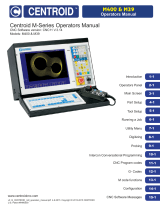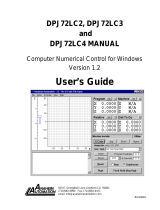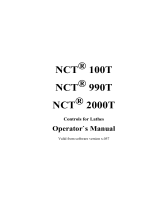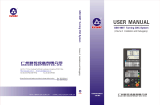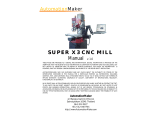
Installation manual.
Quercus
CNC 8060
CNC 8065
ꞏ4ꞏ
REF: 2010
2.11.4 Time setting (system)................................................................................................. 97
2.11.5 CAN bus configuration. .............................................................................................. 98
2.11.6 Serial line configuration.............................................................................................. 98
2.11.7 Default conditions (sytem). ........................................................................................ 98
2.11.8 Arithmetic parameters................................................................................................ 99
2.11.9 Volumetric compensation tables. ............................................................................. 101
2.11.10 Execution times........................................................................................................ 102
2.11.11 Numbering the digital inputs (CAN bus)................................................................... 103
2.11.12 Numbering the digital outputs (CAN bus). ............................................................... 104
2.11.13 Numbering of analog inputs for temperature sensors PT100. ................................. 105
2.11.14 Probe setting............................................................................................................ 106
2.11.15 Shared PLC memory. .............................................................................................. 108
2.11.16 Management of local I/O.......................................................................................... 108
2.11.17 Synchronized switching. .......................................................................................... 109
2.11.18 PWM (Pulse-Width Modulation)............................................................................... 110
2.11.19 Backup of non-volatile data...................................................................................... 111
2.11.20 Tool offset and wear. ............................................................................................... 112
2.11.21 Spindle synchronization. .......................................................................................... 112
2.11.22 Define the number of jog panels and their relationship with the channels............... 113
2.11.23 Rename the axes and the spindles.......................................................................... 113
2.11.24 Zero offsets. ............................................................................................................. 114
2.12 General machine parameters. Execution channels. .................................................... 115
2.12.1 Channel configuration. ............................................................................................. 115
2.12.2 Configuring the axes of the channel. ....................................................................... 116
2.12.3 Configuring the spindles of the channel................................................................... 119
2.12.4 Configuration of the C axis....................................................................................... 120
2.12.5 Time setting (channel). ............................................................................................ 121
2.12.6 Configuration of the HSC mode (channel). .............................................................. 122
2.12.7 Virtual tool axis......................................................................................................... 126
2.12.8 Default conditions (channel). ................................................................................... 127
2.12.9 Arc center correction................................................................................................ 133
2.12.10 Behavior of the feedrate and the feedrate override. ................................................ 134
2.12.11 Override of the dynamics for HSC. .......................................................................... 135
2.12.12 Movement of the independent axes......................................................................... 135
2.12.13 Definition of the subroutines. ................................................................................... 136
2.12.14 Tabletop probe position. .......................................................................................... 138
2.12.15 Block search. ........................................................................................................... 140
2.12.16 Interruption subroutines. .......................................................................................... 140
2.12.17 Machining feedrate. ................................................................................................. 141
2.12.18 Rapid traverse for the automatic mode.................................................................... 142
2.12.19 Maximum acceleration and jerk on the tool path. .................................................... 143
2.12.20 Maximum frequency on the tool path....................................................................... 143
2.12.21 "Retrace" function. ................................................................................................... 144
2.12.22 Enable tool withdrawal (retraction) in threading....................................................... 145
2.12.23 Master spindle.........................................................................................................
. 145
2.13 Machine parameters for the axes and spindles. .......................................................... 146
2.13.1 Belonging to the channel. ........................................................................................ 146
2.13.2 Axis type. ................................................................................................................. 147
2.13.3 Hirth axis. ................................................................................................................. 147
2.13.4 Axis configuration for lathe type machines. ............................................................. 148
2.13.5 Synchronization of axes and spindles...................................................................... 149
2.13.6 Configuration of the rotary axes............................................................................... 150
2.13.7 Module configuration (rotary axes and spindle). ...................................................... 152
2.13.8 Configuration of the C axis....................................................................................... 152
2.13.9 Configuration of the spindle. .................................................................................... 153
2.13.10 Spindle override change while threading. ................................................................ 155
2.13.11 Runaway protection and tendency test.................................................................... 156
2.13.12 PLC Offset. .............................................................................................................. 157
2.13.13 Dwell for dead axes. ................................................................................................ 158
2.13.14 Radius / diameter..................................................................................................... 159
2.13.15 Home search............................................................................................................ 159
2.13.16 Configuration of the probing movement................................................................... 160
2.13.17 Repositioning of the axes in tool inspection............................................................. 161
2.13.18 Configuration of the independent axis. .................................................................... 161
2.13.19 Configure the maximum safety limit for the feedrate and for the speed. ................. 162
2.13.20 Sampling period of the position loop........................................................................ 163
2.13.21 JOG mode................................................................................................................ 164
2.13.22 Filters. ...................................................................................................................... 169
2.13.23 Work sets. ................................................................................................................ 170
2.14 Machine parameters; axis set...................................................................................... 172
2.14.1 Software axis limits. ................................................................................................. 172
2.14.2 Work zones. ............................................................................................................. 173
2.14.3 Loop setting. ............................................................................................................ 173
2.14.4 Backlash compensation with additional command pulse......................................... 174
2.14.5 Configuring feedbacks. ............................................................................................ 177




















